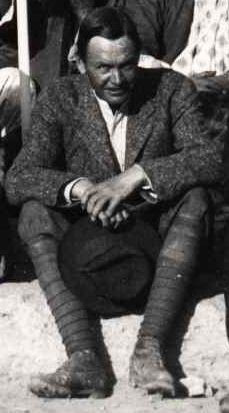Leonard Woolley facts for kids
Quick facts for kids
Leonard Woolley
|
|
|---|---|

Woolley in 1915
|
|
| Born |
Charles Leonard Woolley
17 April 1880 |
| Died | 20 February 1960 (aged 79) London, England
|
| Known for | excavations at Ur in Mesopotamia |
| Spouse(s) |
Katharine Woolley
(m. 1927; died 1945) |
| Scientific career | |
| Fields | Archaeology; military intelligence |
Sir Charles Leonard Woolley (born April 17, 1880 – died February 20, 1960) was a famous British archaeologist. He is best known for his important digs at Ur in Mesopotamia, an ancient region.
Woolley is seen as one of the first "modern" archaeologists. He dug in a very careful way, keeping detailed notes. These notes helped him understand and show how people lived long ago. He was made a "Sir" in 1935 because of his big contributions to archaeology. He was married to another British archaeologist, Katharine Woolley.
Contents
Early Life and Education
Leonard Woolley was born in Clapton, London. His father was a clergyman, a leader in the church. He had two brothers, one of whom, Geoffrey Harold Woolley, won a very brave award called the Victoria Cross.
Young Woolley went to school at St John's School in Leatherhead. Later, he studied at New College, Oxford University. He showed an interest in digging up ancient sites from a young age.
Woolley's Archaeology Career

In 1905, Woolley started working at the Ashmolean Museum in Oxford. His first dig was in 1906 at a Roman site called Corbridge, near Hadrian's Wall in England. He later said he didn't know much about how to dig properly back then. But even so, an important stone carving, the Corbridge Lion, was found under his watch.
After Corbridge, Woolley traveled to Nubia, in southern Egypt. There, he worked on digs from 1907 to 1911. They explored ancient towns and sites like Buhen and Karanog.
From 1912 to 1914, he dug at the Hittite city of Carchemish in Syria. A famous person named T. E. Lawrence (also known as Lawrence of Arabia) was his assistant there.
World War I and Later Digs
During World War I, Woolley was sent to Cairo. He later moved to Alexandria, where he worked on naval intelligence. He was captured by Turkey while on a ship. He was held as a prisoner of war for two years. After the war, France gave him an award called the Croix de Guerre for his service.
After the war, Woolley went back to Carchemish. He also worked at Amarna in Egypt.
Discoveries at Ur
Woolley began his most famous dig in 1922 at the ancient city of Ur. This was a joint project between the British Museum and the University of Pennsylvania. His wife, Katharine Woolley, who was also an archaeologist, joined him.
At Ur, they made amazing discoveries. These included the Copper Bull and the Bull-Headed Lyre. They also found the Ram in a Thicket figurines.
The most exciting finds were in the royal cemetery. This was where many ancient Sumerian kings and queens were buried. The Woolleys found tombs filled with incredible riches. These included gold and silver jewelry, cups, and other beautiful items.
The most amazing tomb belonged to "Queen" Pu-Abi. Her tomb had never been robbed! Inside, they found many well-preserved objects. A special seal with her name in the Sumerian language was also there. Her body was found with two attendants. It seemed they had been poisoned to continue serving her after death. Woolley was able to figure out how Queen Pu-Abi's funeral ceremony might have happened.
The famous mystery writer Agatha Christie visited the Ur dig. Her novel, Murder in Mesopotamia, was inspired by the royal tombs. Agatha Christie later married Woolley's young assistant, Max Mallowan.
Digs in Syria
After his work at Ur, Woolley wanted to find links between ancient Aegean and Mesopotamian cultures. This led him to the Syrian city of Al Mina in 1936.
He also dug at Tell Atchana from 1937–1939 and again from 1946–1949. His team found palaces, temples, homes, and strong walls. They uncovered 17 different layers of history, showing life from about 2200 BC to 1300 BC. One important find was a statue of Idrimi, a king from around 1500 BC.
The Great Flood Idea
Woolley was one of the first archaeologists to suggest that the great flood story in the Book of Genesis might have been a local event. He found evidence of a huge flood at Ur. He thought this flood was "400 miles long and 100 miles wide." For the people living in that valley, that would have felt like the whole world was flooded.
World War II Role
Woolley's archaeology work was paused during World War II. He joined a special group called the Monuments, Fine Arts, and Archives Section. This group worked to protect important historical sites and art during the war. After the war, he returned to Alalakh and continued his digs until 1949.
Personal Life
Leonard Woolley married Katharine Elizabeth Keeling in 1927. She was born in England to German parents. Katharine was an artist and helped with drawings at his dig sites. She played a very important role in his archaeological work.
In 1930, Woolley invited his friend, the writer Agatha Christie, to visit his dig in Iraq. It was there that Agatha Christie met her second husband, Max Mallowan.
Sir Leonard Woolley passed away on February 20, 1960, at the age of 79.
Images for kids





